Mindfully Using Music, Movement and Manipulatives
There are so many fun ‘things’ to use when doing music and movement. It is one of the reasons I love being a music teacher. Anyone who works with children should use these tools. Although it looks like just fun, it isn’t! Nope. There’s mindful purpose and reason for the use of each manipulative. Let’s explore each individually.

Bean Bags
The first thing someone does when they have a bean bag in their hands is tactile. They squish it, shake it and poke it to figure out “What’s inside?” This helps to develop the FINE MOTOR SKILLS of the fingers. When they push down on the beans in the middle and they move, that's SCIENCE! They are learning displacement. When they toss a bean bag up in the air and it comes down, that's gravity. This is the little scientist at work.
Here are some things to do with bean bags and the outcome.
Activity Learning Benefit
- Toss a bean bag up and catch Prediction and confidence
- Walking with a bean bag on the head Balance; strengthen vestibular system
- Placing bean bag on body parts Language; body understanding
- Playing catch with another Social skill; sharing; coordination
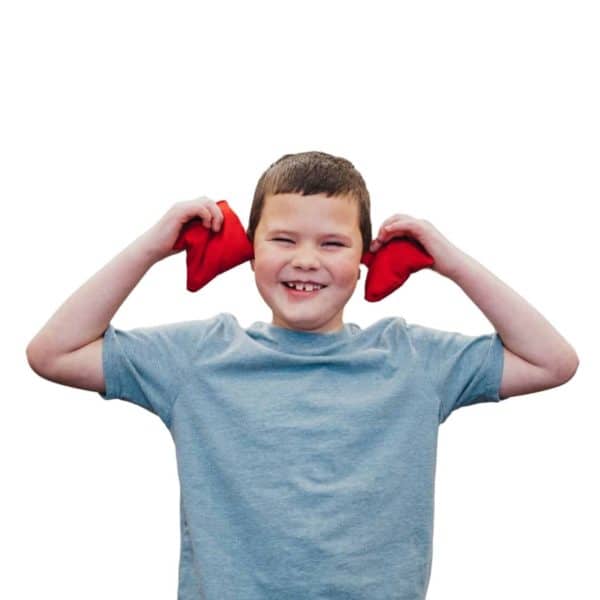
There are many songs using bean bags. The combination of music with the bean bag activities intensifies the learning experience. Music helps the children utilize the bean bags in a constructive way while making it easier to understand. Because of music, they will retain what they've learned a bit longer as well.
Music with Mar. music, movement, and manipulative distance learning kits available from Bear Paw Creek Share on X
Scarves
Scarves are light and easy to move. Using ones that can be seen through is helpful for infants/toddlers who have not developed object permanence yet. They can still see you when you use a scarf to play “Peek-a-boo”.
National Association of PE Teachers has a list of motor and non-locomotor words that children should be familiar with before leaving Kindergarten. All these words can be used while moving with a scarf. Invite children to walk, skip, slide or spin with a scarf in their hand. Other motions can be added, ie spin in a circle and twirl the scarf above your head. That one direction uses four movement / placement words.

Peering through a scarf puts a color filter on what is on the other side. Have the children look through the different colors and ask what they see. This leads to curiosity to try all the colors.
Scarves can also be used as a movement prop. Put on different styles of music and just move around with the scarf. It’s fun and creative while developing spatial temporal reasoning.
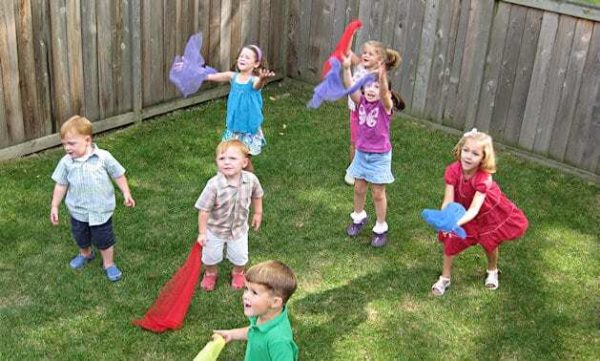
Shaker Eggs
Shaker eggs are held in the hand as they are moved to produce a sound.
These can be used with infants and will help to develop their grip.
There is so much wonder when moving the hand produces a sound!
Shaker eggs can be used to teach opposites as they shake them high / low, fast / slow, to the side / in the front.
These are also simple instruments to move along to the beat.
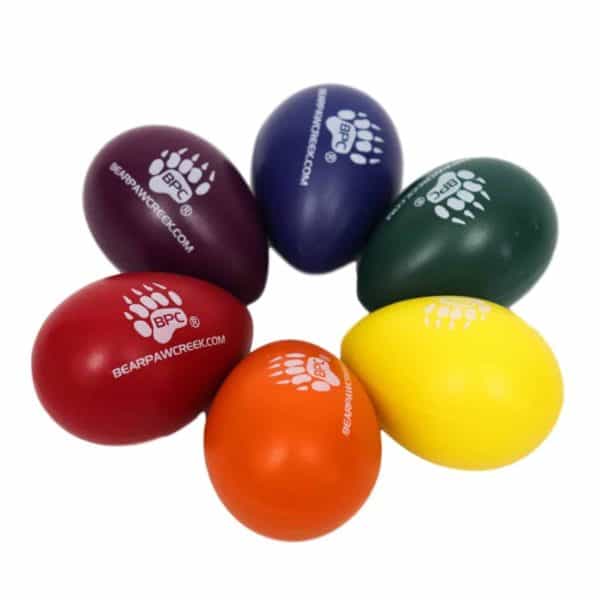
Rhythm Sticks
Rhythm sticks are wonderful instruments that do so many things for language. Here are a few:
- Tapping out all the sounds in a word
- When we tap out each syllable, the ear can hear even the unaccented ones, sometimes, children cannot hear the unaccented sounds;
- It’s important to then tap out the word with its regular rhythm
- Finding steady beat.
- Children by the age of 3 should be able to find a keep a steady beat for 2 – 3 minutes. This leads to reading proficiency
- Repeating patterns
- Use of different patterns is good for language and mathematics
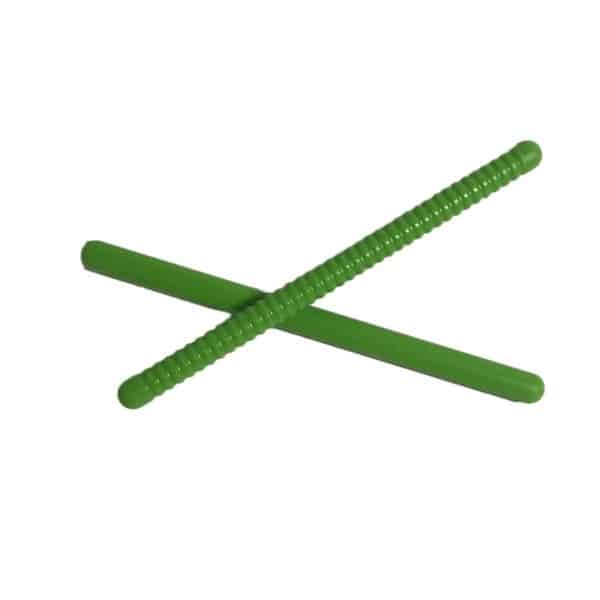
Kazoo
Anyone who has been to any of my classes or workshops knows that I LOVE to use kazoos! They are easy, inexpensive and, to be punny, quite instrumental in learning. Here are some skills kazoos help to build.
- When you hum into a kazoo, it vibrates the bone structure in your head, thus energizing the brain and stimulating the vestibular system
- Helps develop inner voice (the process through which we hear ourselves think and listen internally.) This is because you have to think about what you are going to play before you actually do it;
- Children without inner voice need to hear something to understand it. (The child who comes to your desk to ask you “Is this what this says?”)
- Inner voice should be in place by 7 or 8 and is necessary for higher-level thinking.
- Provide a way to have fun. Within moments, anyone can be a kazoo player.
- Get a group of people together with kazoos and you get the feeling of playing together as in a band;
- Enhance language development. Supporting the air flow out of the kazoo helps children who have difficulty with this skill when speaking;
- Develops confidence and an interest in learning an instrument.
- When a child plays the kazoo successfully, they get the message they can try something else and be successful as well;
- Allow for self-expression and self-esteem;
- Encourages children to want to keep music a part of their lives because it is fun and something they enjoy.
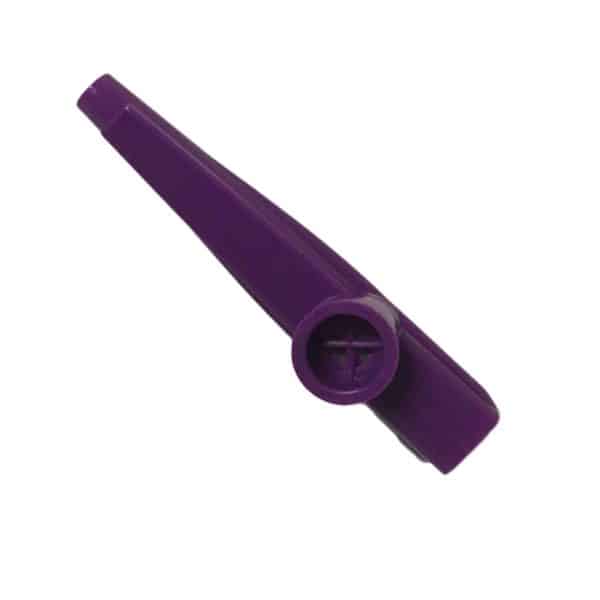
Parachute
(Bear Paw Creek does not currently make a parachute, but offers the 54" Scarf or 9' Canopy Scarf as an alternative.)
Every time I take the parachute out, the children come and get as close as they can. They are so excited to hold onto their little piece and participate in whatever we are about to do.
- Working together to hold the parachute is a social skill.
- Moving the parachute up and down creates wind. Science!
- Walking together in a circle takes cooperation
- If someone lets go, pulls or tries to go fast, it doesn’t work.
- There can be two groups – one under the parachute and one holding it
- Those underneath watch as the wind pulls the parachute up and down
- Those holding the parachute learn to control the movement
- Things can be placed on the parachute. The children move it up and down and try to keep from falling off.
I’m going to segue way this into the Stretchy Band because there are a lot of similar things that can be done.
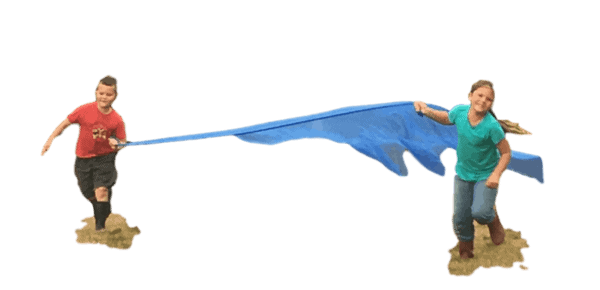
Stretchy Band
From cooperation and working together, to flexing muscles to stretch and move the stretchy band, this is one of the BEST manipulatives you can have in your classroom. It is so versatile. Having the ability to add or subtract sections is a big plus because you can make it be the size you need / want. .
The various colors are useful in giving each child their own spot or color. When first introducing this to the children, have them stand around it with it being on the floor. Instruct them to each pickup one color. Everyone will then be standing and holding the stretchy band.
Tell them to take 3 tiny steps back. (If you just tell them to take steps, there will most likely be a lot of pulling. Safety is first.) As they step out and then back in, they are learning the science concept of stretch and relax. Gradually, they will pull the band out as far as they can and then slowly walk back in. Children think this is amazing. And, I kind of agree!
The stretchy band can be used sitting or standing.
- Sitting on the floor and rowing like in a boat works all those arm and back muscles.
- Pulling on the band until you lay flat on the ground, helps strengthen the stomach muscles. It is similar to doing sit-ups.
- Working the band in and out with your arms, like pedaling a bike, builds strong arm muscles
- Holding the stretchy band up over your head and pulling your section in opposite directions builds strength.
Another use is taking just one section of the band and using it to help with behavior management. Two children who need to learn to work together can stand inside and find a way to work together.

Use your creativity and make up your own games to play with the stretchy band. There are so many uses for it and many new ones to explore.
Balloon Ball
When I was young, I loved getting a new ball. There are so many games to play! I’m sure you know many of them. For this blog, I’d like to focus on things that can be done with a ball IN the classroom. These teach control, turn taking, vocabulary and following directions.
- Sit on the floor in a circle with legs straddled and feet touching the person across from you, if it’s just two people, or the person to your right and left if more than two.
- First the ball is rolled from person to person.
- Each person must pay attention for when the ball comes to them
- Second command is to toss the ball from person to person
- Toss is different than throw, usually down underhand. Explain the difference.
- Builds vocabulary
- Third command is to stand up and PUSH it with your foot
- The word push is used, not kick. Kicking implies a forceful movement; push is gentle
- Explain the word and show how to move the ball with the side of your foot – as in soccer.
- The last part, the children sit back down and roll the ball one more time
- This gets everyone back down and seated
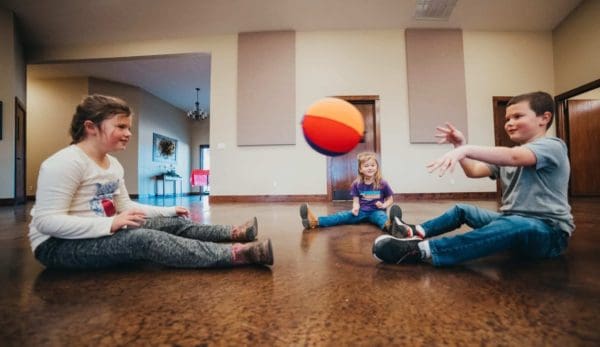
"There are other manipulatives that can be and are used with children. These are just a few. When we make our activities mindful and fun, children will have that joy and the skills for a lifetime. They will most likely pass them down to their children." Maryann "Mar." Harman


